Wild Drift
A patch plan inspired by Cornish wild meadows and coastal light. Wild Drift blends ox-eye daisies, foxgloves, thrift, and swaying grasses in a naturalistic flow that welcomes pollinators and celebrates place.

A patch plan inspired by Cornish wild meadows and coastal light. Wild Drift blends ox-eye daisies, foxgloves, thrift, and swaying grasses in a naturalistic flow that welcomes pollinators and celebrates place.
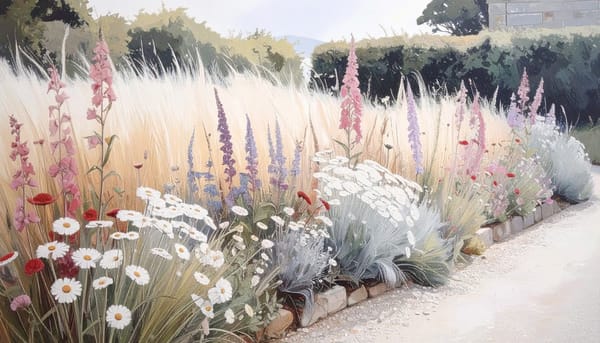
A Cornish Patch Plan for Movement, Meadow, and Meaning
There’s something about a Cornish meadow in the wind. The way grasses lean, the way wildflowers nod and shimmer, the way the land itself seems to breathe.
Wild Drift is a garden patch designed to capture that feeling. Loosely planted, pollinator-friendly, and shaped by natural rhythms, it’s a tribute to the quiet drama of coastal Cornwall—where hedgerows give way to sea breezes, and native flowers thrive in their own unruly choreography.
This patch plan is not a rigid formula but a mood, expressed through different compositions. We've created a series of images to explore how the same palette of plants can be arranged to suit varying garden settings—from curved beds and borders to sloping banks and dry-stone edges. Each version offers a slightly different take on the same idea: to let the planting feel free, generous, and a little wild.
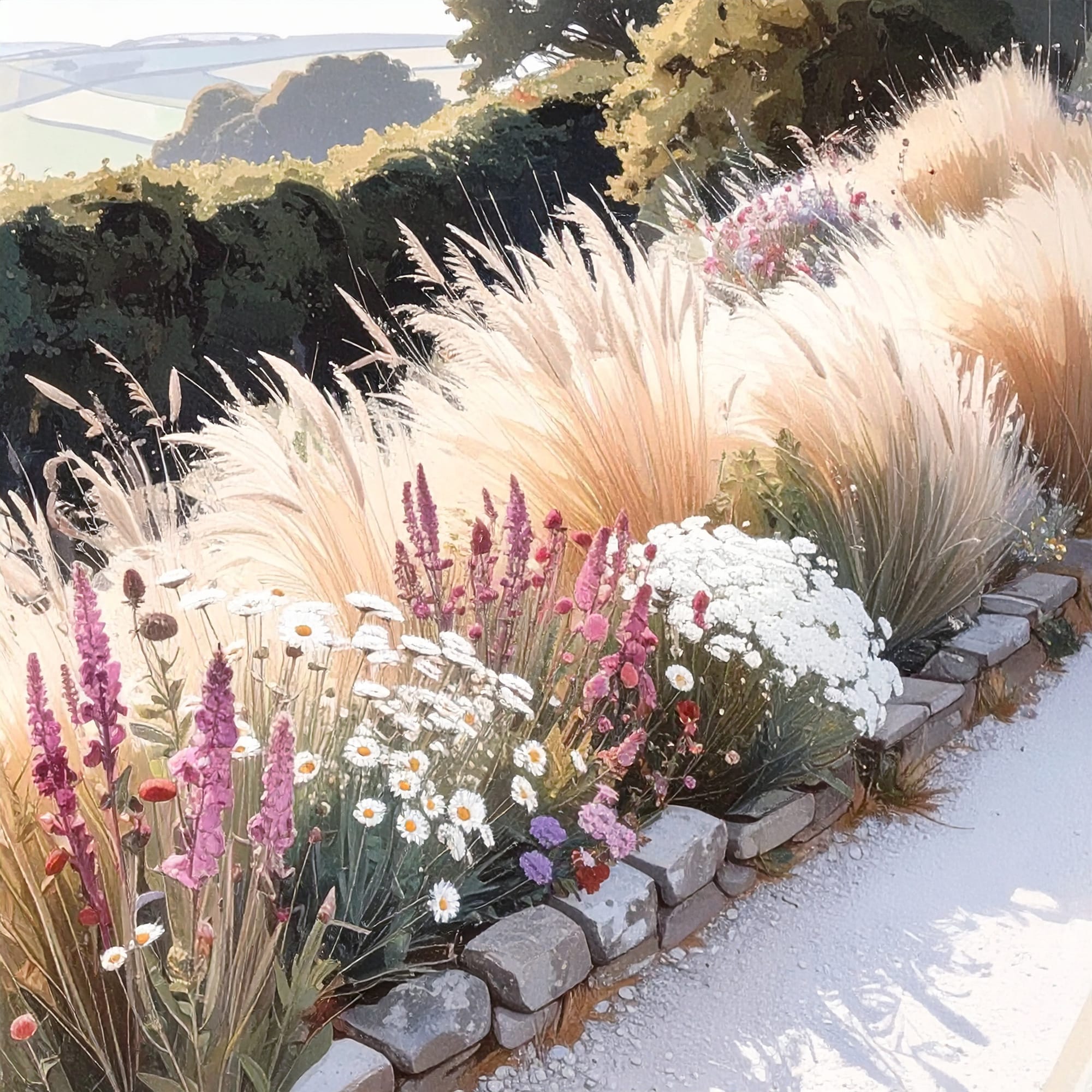
At its core, Wild Drift brings together native and naturalised plants that evoke meadowland and edge-of-the-path beauty. The colour story blends warm golds, dusky pinks, soft purples and whites. The movement comes from fine grasses, layered heights, and flower forms chosen for their lightness and natural lean.
The planting is pollinator-rich, low-maintenance, and well suited to coastal and sunny Cornish conditions. It favours plants that are long-flowering, nectar-rich, and either locally native or sympathetically adapted cottage-garden types.
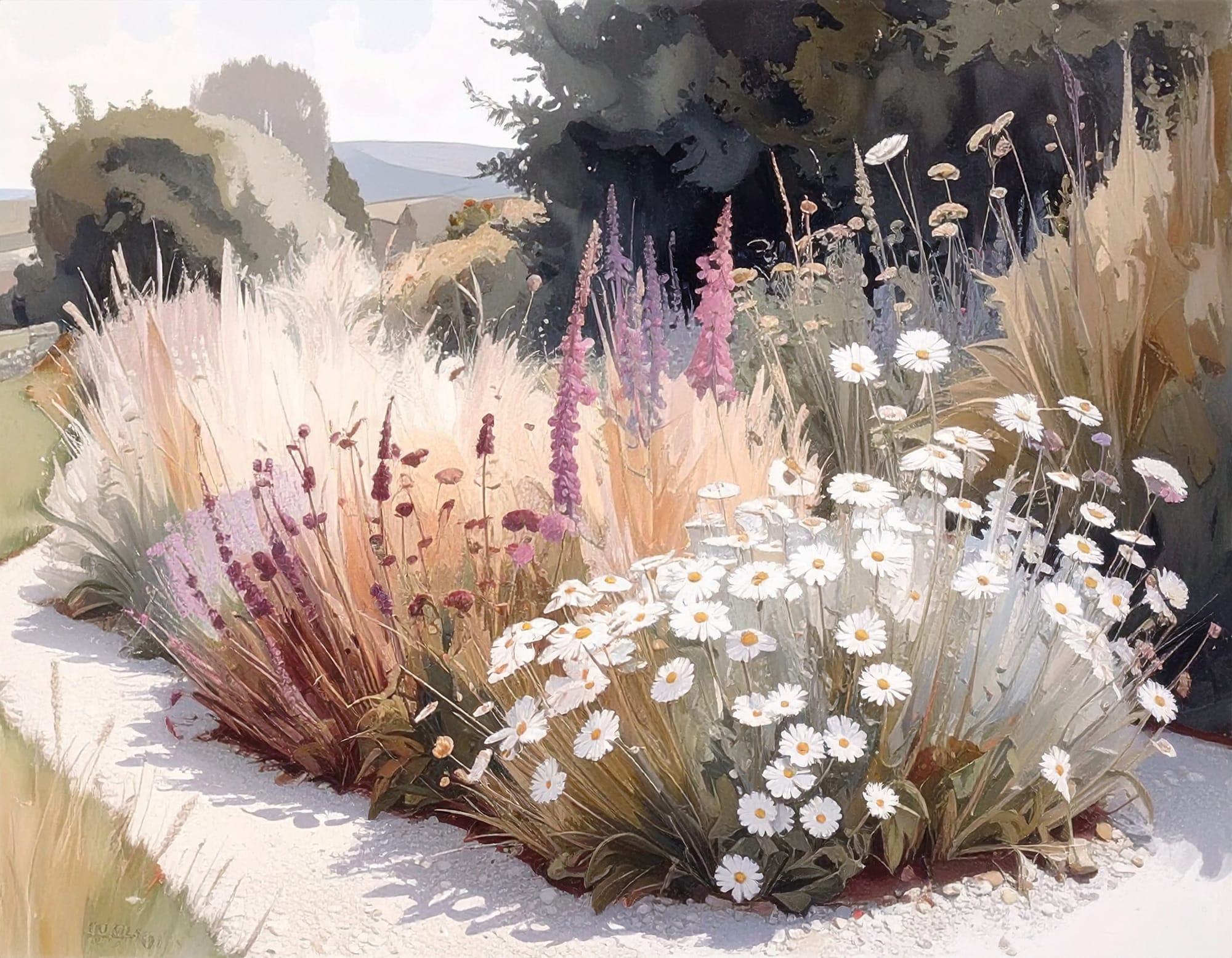
This is a scheme that adapts to its context. It thrives in lean soils and doesn’t demand constant feeding or irrigation. In fact, many of the plants in this plan benefit from a little hardship—they bloom longer, sway more freely, and self-seed gently over time.
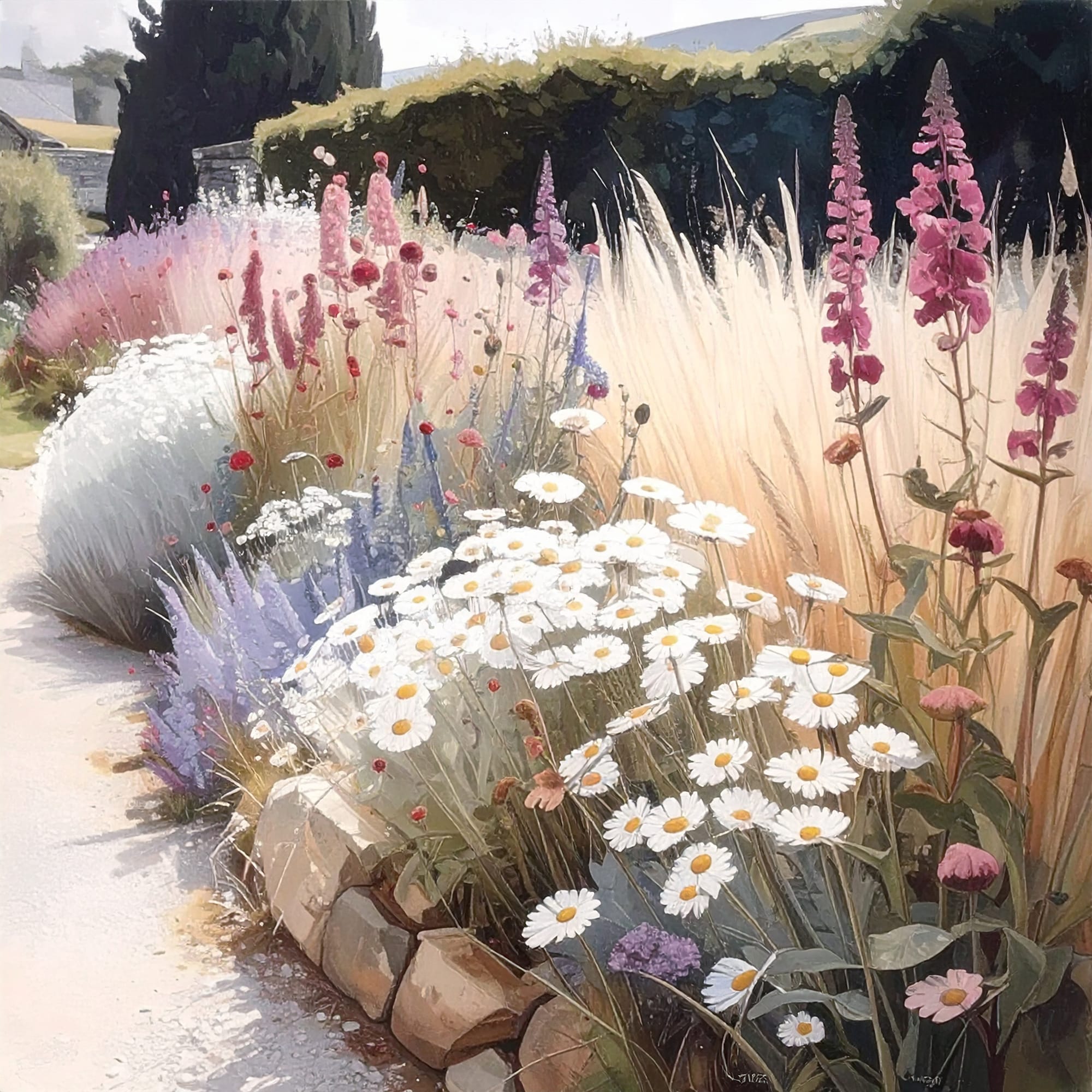
Each image features variations of the following species, which form the backbone of the design:
These can be planted in repeating clumps, or woven together more freely depending on your space. The aim is not strict symmetry but a loose, layered feel that looks different from every angle.
To help visualise how Wild Drift could be interpreted in your own garden, we’ve created multiple image versions:
Each version features the same palette and principles, adapted slightly in composition and density.
Wild Drift is more than a planting plan—it’s a quiet homage to Cornwall’s wild edges. It invites softness into your garden. It moves, it leans, it hums with life. And perhaps most importantly, it reminds us that a garden can be both beautiful and ecological, both designed and a little undone.
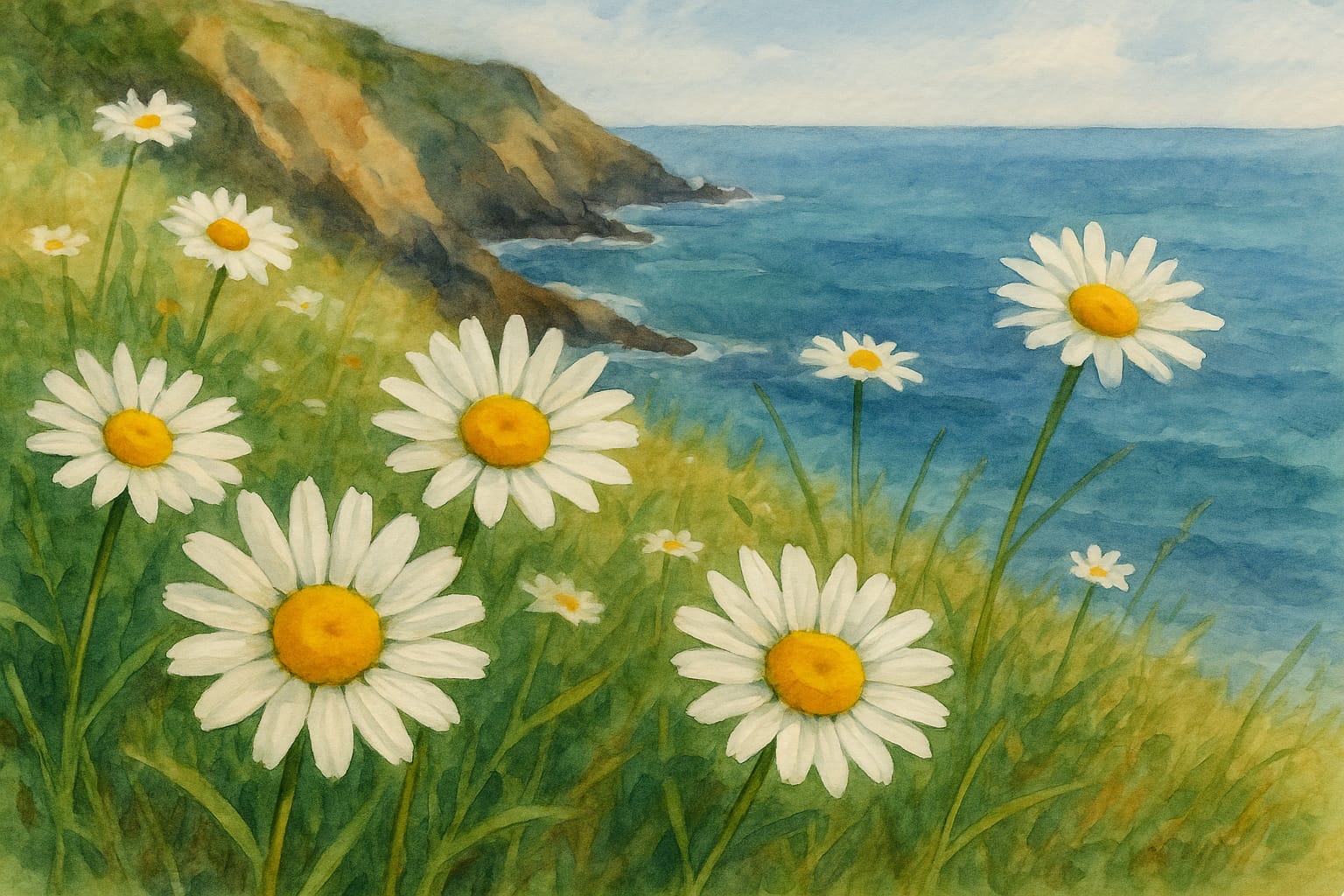
A Midsummer Bloom of Memory, Myth, and Meadow
White-petalled, golden-hearted, and gently swaying beneath the Cornish sky, the Ox-Eye Daisy is one of those flowers that feels older than time. It reappears each summer with effortless grace, stitching together past and present in meadows, verges, and gardens touched by wildness.
A Flower of Dreaming and Devotion
The Ox-Eye Daisy carries a lineage steeped in both myth and meaning. In Cornwall and across the British Isles, it has long been seen as more than a simple bloom.
Folkloric Echoes
Once known as Moon Daisy, Maudlin Daisy, and Moonpenny, this flower has been linked with the lunar deities Hera and Diana. It symbolises purity and longing, its petals used in age-old rituals to divine the heart’s truth: “He loves me, he loves me not.”
In Cornish folk practice, maidens placed daisies beneath their pillows on midsummer's eve, hoping to glimpse the face of a future love in dream. The daisy’s open face, shining like a silver coin under full sun, made it a natural symbol of honesty and hope.
Historical Traces
Christian legend dedicated it to Mary Magdalene. It was worn as a personal emblem by Margaret of Anjou, and later became a cottage remedy for colds, cuts, and digestive complaints. In rural households, it even made its way into stable bedding—its sap thought to repel fleas.
The Daisy as Ecosystem Builder
Despite its romantic reputation, the Ox-Eye Daisy is no mere ornament. It’s a foundational species in traditional field margins and rewilded spaces.
Growing Ox-Eye Daisies: Coastal-Friendly, Low-Fuss Beauty
For gardeners along Cornwall’s coasts—or anywhere seeking a naturalistic planting—Ox-Eye Daisy is both practical and poetic.
Growing ConditionsFactorRecommendationSunlightFull sun ideal; copes with light shadeSoilSandy or loamy, well-drained, mildly acidic to neutralMoistureMoist at first, drought-tolerant when establishedExposureWind and salt-tolerant—perfect for coastal gardensHardinessVery hardy; reliable across all UK zonesGarden Care
Companions and Meadow Partners
In naturalistic or meadow-style schemes, Ox-Eye Daisies pair well with:
Why It Belongs
Ox-Eye Daisy is more than a marker of midsummer. It is part of a living memory that connects us to a quieter, slower landscape—one that once bloomed at the field edge, along a footpath, or beneath a Cornish stone wall.
It asks for little, offers much, and returns faithfully each year—a wildflower with roots in both the soil and the soul.
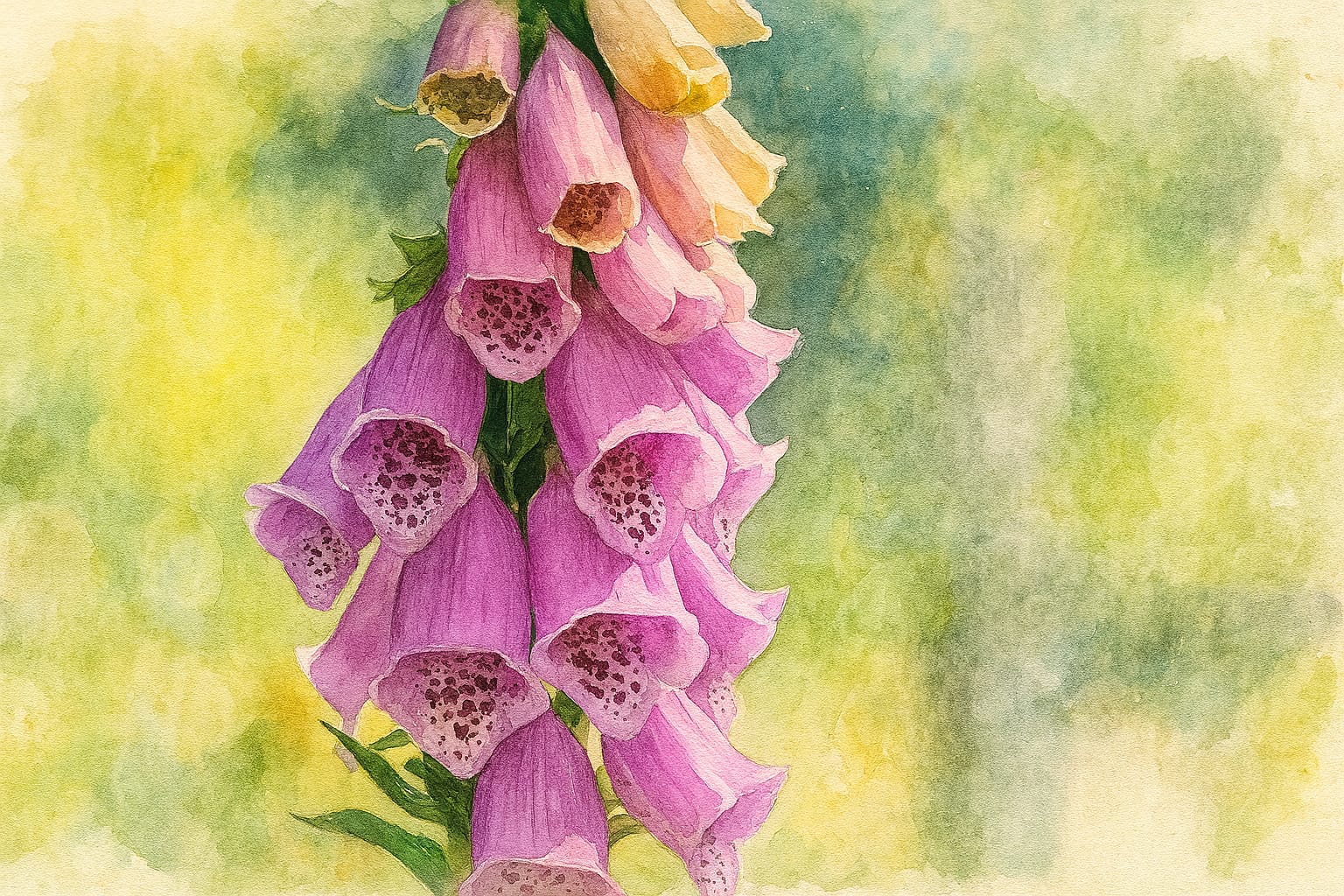
Spirits in the Spires: A Plant of Myth, Medicine, and Mystery
In a shady glade or beside a hedge where the sun slips softly through, a tall, spired flower leans into the breeze. Its blooms nod like tiny bells, whispering secrets from a time when fairies danced along the wood’s edge. This is foxglove—both feared and revered in Cornish memory.
Where Folklore and Poison Bloom Side by Side
Foxglove has long stood at the edge of two worlds: beauty and danger, healing and harm, natural and otherworldly.
Enchanted by Fairies
Known in Cornwall as Fairy’s Glove or Piskie’s Thimbles, foxglove was believed to be worn by woodland spirits. Its speckled throats were said to carry the fingerprints of fairies, left behind as they guided bees into the flowers. To pick a foxglove was to risk offence—many believed it could bring misfortune or summon the wrath of unseen beings.
Protective and Perilous
Despite its associations with mischief, foxglove was also a guardian. Hung above cradles or tucked into shoes, it was thought to shield children from witchcraft or the ‘evil eye’. Yet superstition warned against bringing the plant indoors. It held a dual nature—protector in the field, omen in the hearth.
The Wise Woman’s Remedy
Foxglove’s place in folk medicine is well documented, particularly among herbalists and midwives. Though toxic, its potent compounds were used in tightly guarded recipes. Its transformation from folklore to science began with Dr. William Withering, who, in the late 1700s, harnessed its properties to treat heart failure—a medical breakthrough still echoed in modern cardiology.
A Symbol of Contradiction
In Victorian floriography, foxglove meant insincerity—perhaps a nod to its duplicitous nature. In Cornwall, it is more often seen as a symbol of threshold places: between summer and autumn, life and death, the human and the enchanted. It’s a plant that carries riddles in its roots.
Growing Foxglove by the Coast
Wild yet stately, foxglove fits naturally into Cornish coastal gardens, especially in moist, semi-shaded corners or the wilder edges of a cultivated plot.
RequirementDetailLightPrefers partial shade or morning sunSoilMoist, well-drained, rich in leaf mould or compostWateringKeep soil evenly moist; dislikes drying out completelyExposureModerate salt tolerance; ideal for sheltered coastlinesHardinessFully hardy across the UKCare Notes
Folklore in Bloom
Whether edging a path, lighting up a slope, or tucked between ferns and fuchsia, foxglove brings more than flowers to the garden. It brings story. In coastal areas, it thrives naturally in moist, free-draining soils and lends vertical drama to any planting scheme.
With every nod of its purple bell, it recalls a tale half-told—of witches, wise women, and the hidden folk who might still dance in the mist if you’re quiet enough to hear them.
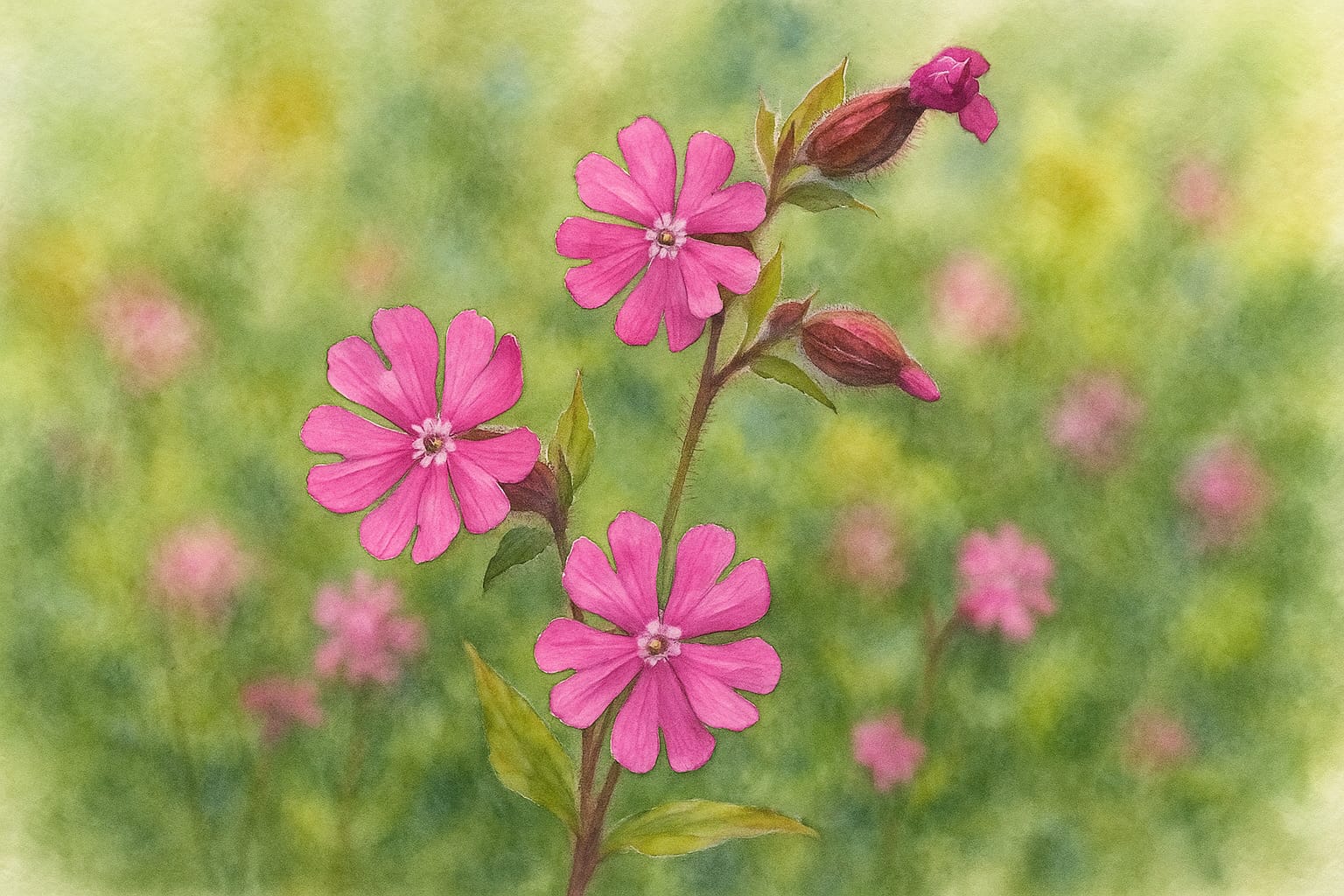
Wild Memory in Bloom
Among mossy hedge banks and tree-shadowed lanes, where the land drifts between cultivated and wild, a pink flower flickers through the green. Tall, slender, and gently nodding in the breeze, Red Campion (Silene dioica) is not just a harbinger of summer—it’s a thread of folklore, a marker of place, and a quiet guardian of Cornish landscapes.
A Wildflower Woven with Story
Red Campion is the kind of flower that returns year after year as if it’s always belonged. Across Cornwall, it lines old paths, tucks into shaded garden corners, and reclaims forgotten edges. But it’s more than beautiful. In the cultural memory of this place, it’s a plant of meaning.
Whispered Warnings and Woodland Lore
Known locally as “Fairy Flower” or “Adder’s Flower,” Silene dioica has long been tied to the unseen. In some villages, children were warned never to pick it from hedgerows—it was said to protect fairy treasure or mark sacred ground. To bring it indoors was to invite bad luck, a superstition that echoes old warnings about bluebells and foxgloves.
Its sticky stems and vivid blooms made it memorable, even magical. Those same traits are why it was believed to guard bee stores from thieves, both human and otherworldly. Its position on the edges of woods and fields—never quite tame, never fully wild—gave it a reputation as a boundary plant. Something of a watchful presence.
A Shifting Form, Season to Season
Red Campion is wonderfully responsive to place and time. Its look shifts with the light, the soil, and the season.
Early Spring: Quiet Emergence
As early as March, rosettes of soft, slightly hairy leaves begin to surface in sheltered spots. These low-growing clusters set the stage for what’s to come. If the season is mild, the first flowers appear in April—delicate, notched, and bright rose-pink.
Midsummer: A Cascade of Colour
By June, Red Campion stands tall. In hedgerows, it stretches a metre or more, with clusters of flowers rising above lush, green foliage. In sun-exposed places near the coast, it may be shorter and more compact, but no less vibrant. In woodland edge gardens or along stone paths, it mingles with oxeye daisies, grasses, and ferns—natural, loose, always dynamic.
Autumn and Beyond: Subtle Decline
As temperatures cool, flowering slows. Seed capsules swell and dry to a crisp brown, rattling with the promise of next year. The plant fades gracefully, leaving behind structural interest and seeds for birds and wind alike. In Cornwall’s gentler microclimates, a few late blooms may hang on through October.
A Flower for Every Habitat
The beauty of Silene dioica lies in its adaptability. It transforms according to its environment.
Red Campion can root itself into nearly any corner of a Cornish garden—especially those with dappled light, humus-rich soil, or an appreciation for what looks a little untamed.
The Ecology of Red Campion
Beyond folklore, Silene dioica plays a crucial role in Cornwall’s living systems.
It is both ornamental and functional—a true asset to any wildlife-supporting or restoration-minded garden.
In the Garden: Graceful, Self-Sufficient, and Generous
Red Campion is well suited to naturalistic planting, especially in gardens that honour wildness.
Ideal Companions
Growing Notes
A Keeper of the Edge
Red Campion is not just a flower of hedgerows—it is a keeper of margins. It flourishes in places that slip between cultivated and wild, where birds nest in brambles and bees dart between nettles and fern. It reminds us that beauty does not always ask for centre stage. Sometimes, it simply waits on the boundary, offering colour, memory, and quiet endurance.
In every Cornish lane, in every garden that lets the wild in, it blooms as both story and substance. Silene dioica carries a kind of lived-in poetry—rooted in soil, folklore, and the turning wheel of the seasons.
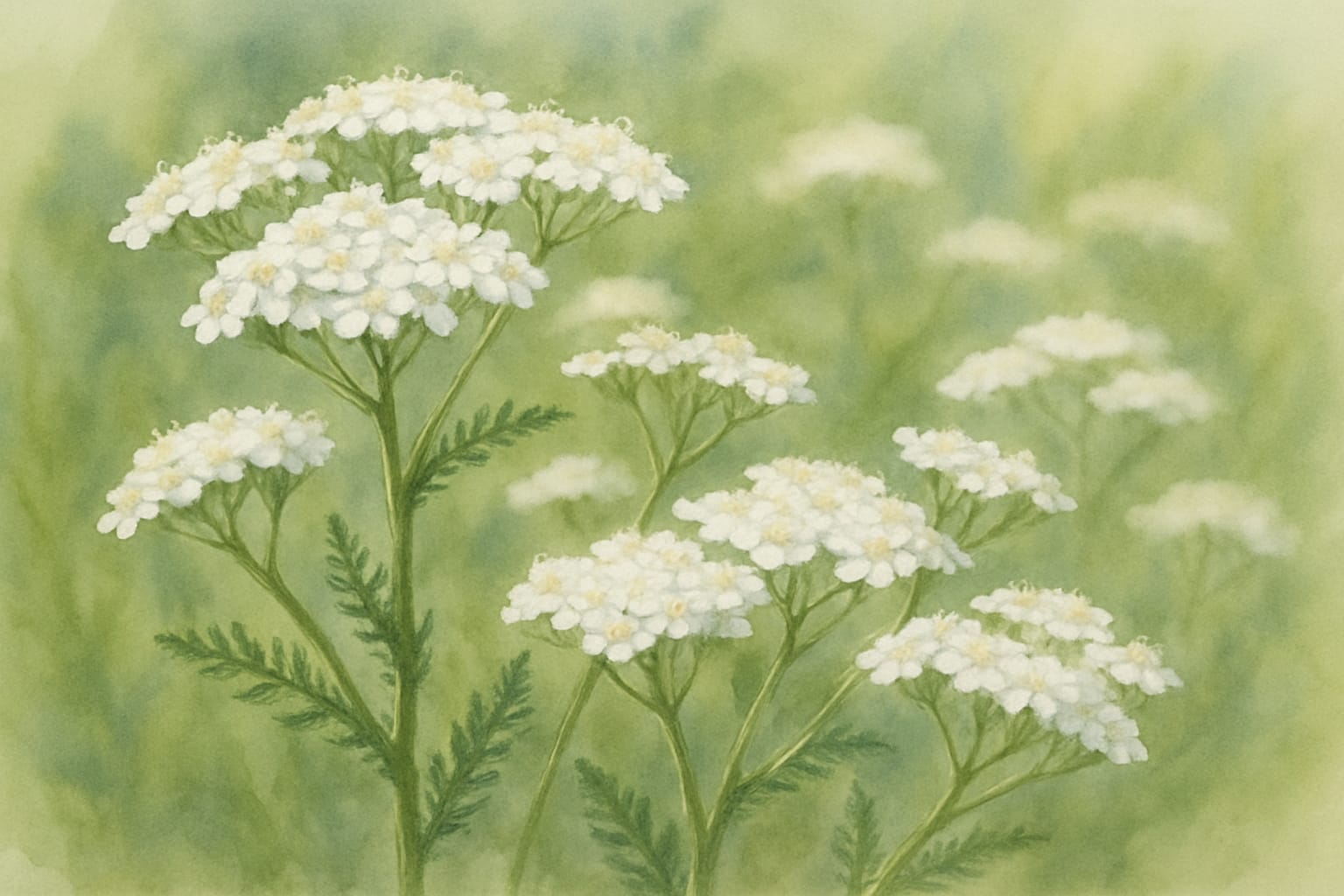
Of Wild Edges and Quiet Strength
On the windswept shoulders of Cornish hedges, in fields where grasses sway like tides, a pale-flowered plant stands quietly among the better-known blooms. Not loud or rare, but utterly steadfast. Yarrow (Achillea millefolium) is one of those plants you think you know—until you take a closer look.
Feathered leaves, like fern lace pressed into soil. Umbels of creamy white or soft blush, hovering above the turf like midsummer constellations. And beneath it all, a story of resilience, medicine, and life woven deep into Cornwall’s meadows and margins.
Memory in the Leaves
The name millefolium—a thousand leaves—captures something of yarrow’s tactile magic. Its foliage isn’t broad or brash. It’s finely cut, soft to the touch, and aromatic when crushed, releasing a scent like wild tea and sun-dried grass. This smell is part memory, part medicine. It lingers in the hands like something half-forgotten but always familiar.
Birds seem to know this too. There are stories of yarrow being woven into nests, its bitter compounds warding off mites. Nature, always the quiet herbalist.
The Way Yarrow Grows
In Cornwall, yarrow rises where land is most alive—in hedgerows, pasture, cliff top, and dune. It does not ask for much. A little sun, a place to root, and the freedom to sprawl. Its fibrous roots seek out nutrients in poor soils, binding banks and steadying loose ground. It spreads not in haste, but with quiet persistence.
By the Seasons:
In wild places, yarrow is constant. In gardens, it becomes something more—a link between cultivated form and wild intent.
Cornwall’s Hedge-Top Healer
Walk along a Cornish hedge in July, and yarrow will likely be there. It grows in the seams—between stone and earth, between wild grass and herbaceous drift. These hedges, ancient and intricate, are more than boundaries. They are living walls, each one layered with history, geology, and ecology.
Yarrow thrives here not just as a flower, but as a system of support. It feeds hoverflies, butterflies, solitary bees, and ladybirds. Its flowerheads are landing pads and banquets, each corymb hosting hundreds of nectar-rich florets. It draws beneficial insects that help balance a garden’s ecology—predators who feed on aphids, pollinators who ensure fruit sets.
Its seedheads linger well into winter, feeding birds and marking time with their soft geometry.
A Long Story of Healing
In folklore and medicine, yarrow is an ancient ally.
Named for Achilles, who reportedly used it to staunch wounds, it has been called soldier’s woundwort, bloodwort, and herbe militaris. Its leaves are anti-inflammatory, astringent, and antimicrobial. Chewed for toothache. Steeped for fevers. Applied to cuts and bruises.
In Cornish folk practice, it became more than medicine. It was protective. Hung in thresholds, it guarded against ill luck. Tucked under pillows, it invited prophetic dreams. Carried in pocket or woven into charms, it offered safety on journeys both physical and spiritual.
Today, herbalists still use it. Gardeners, too. Not for spells or brews, necessarily, but for its structural grace, pollinator magnetism, and ability to settle into a space and make it feel whole.
Yarrow in the Garden: Soft Power and Lasting Presence
Yarrow suits gardens that lean into nature—places where planting flows like meadow, and edges are allowed to breathe. It belongs in dry borders, gravel gardens, wildflower lawns, and between the rows of veg plots.
Planting and Care:
You can let it naturalise, or shape it with more deliberate pairings.
Wild or Tamed? Choosing Your Yarrow
Native yarrow in Cornwall is typically white, sometimes kissed with pink. It’s the version that lives longest, spreads easiest, and supports the broadest range of insects. But cultivated varieties, bred for richer colours, can also have a place.
In all forms, yarrow softens sharp lines, holds space between plants, and lends a feeling of continuity to a border.
Companion to the Land
Yarrow threads itself through Cornwall in ways you might miss if you’re not looking. In the cracks of an old wall. In a gravel layby warmed by sun. At the edge of a field where no one plants anything, yet things still grow.
It is not a flower that needs fanfare. But its gifts are many—food for bees, charm for the eye, calm for the soil. A plant that has held healing in its leaves and strength in its stem for generations.
To welcome yarrow into your garden is to lean into a quieter kind of beauty. One that hums with life, remembers the past, and asks for little more than light and space.
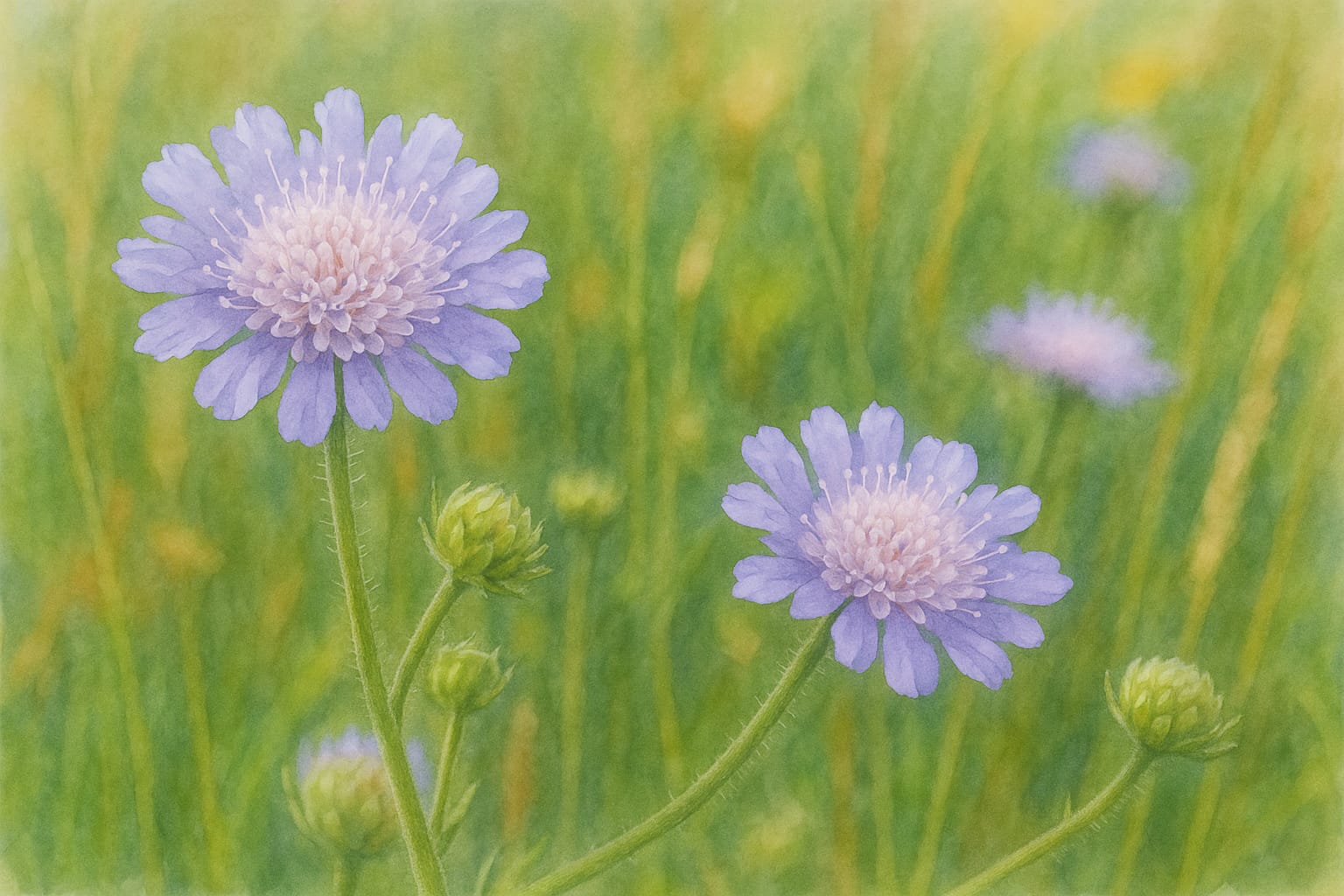
The Lavender Pulse of Cornwall’s Living Meadows
Where grasslands ripple above hidden springs and coastal meadows lean into the sea wind, one flower sways with timeless grace. Knautia arvensis—Field Scabious—is not a flower that shouts. It hums. A low, steady song of colour and nectar, of late-season sustenance and subtle power. In Cornwall, where land and light combine in strange and beautiful ways, this soft-lavender perennial has become both a botanical witness and a participant in the story of climate, place, and pollination.
A Meadow’s Last Lullaby
In the soft geometry of the flower’s domed heads, a hundred tiny florets cluster like the spines of a sea urchin or the memory of a pincushion in a grandmother’s sewing tin. These flowerheads begin to open in early June, catching bees and butterflies with their wide landing pads and generous nectar. But it is their duration—not their arrival—that makes them essential.
In Cornwall, where the seasons blur and elongate under a maritime sky, Field Scabious can bloom through to October. Long after other meadow plants have crisped and browned, this one persists. It catches the last light. It feeds the final flight.
In this, it offers more than colour. It offers continuity. A thread across the shifting weeks of summer, woven through pollinator lives and seasonal change.
Soil Memory and the Places It Thrives
Field Scabious does not favour richness. It grows best where the soil is lean, drained, and free. In Cornwall, it finds its niche in light grassland, coastal dune, and old common—places shaped more by wind and sun than by human hands.
The north coast, with its calcareous dunes and sandy meadows, provides some of the most spectacular displays. At Penhale or Godrevy, scabious weaves its roots through the grit, unfazed by salt spray or shifting sand.
Its preferences are clear:
This is a plant of openness, not indulgence. It roots deeply and asks little, except space to breathe and time to bloom.
The Climate Lens: Shifting Light, Altered Rhythms
Field Scabious has always adapted quietly to the pace of the land. But now the land is changing faster than before.
Earlier Springs, Longer Falls
As spring creeps earlier, the timing of flowering shifts too. Field Scabious may bloom sooner, but if pollinators do not shift in step, this asynchrony could affect fertilisation. No bees means no seed. The quiet chain breaks.
Drought and Downpour
Cornwall’s climate is increasingly erratic. Droughts parch the soil just as buds begin to form. Torrential rains wash out pollinators. In this volatility, even a robust wildflower can falter—especially one so dependent on rhythm and time.
Lost Sites, New Possibilities
While some populations may retreat from traditional lowlands, others may find new footholds further inland or higher up. This requires watchfulness—and sometimes intervention—to help scabious recolonise places newly made suitable by change.
Not Just Pretty: A Keystone for Insects
Stand still beside a flowering Field Scabious and the air seems to flicker. Bumblebees circle, hoverflies dart, butterflies pause, their wings rising and falling like sails. The flower is both magnet and meeting ground.
Its structure—a flat-topped disc, dozens of florets, accessible nectar—is perfect for a wide array of pollinators. From long-tongued bees to delicate skippers, from day-flying moths to parasitic wasps, the bloom welcomes them all.
For this reason, it holds disproportionate importance in late-summer meadows. It is not rare, but it is vital. A single scabious can feed dozens of species, day after day.
Garden Worthy, Wild at Heart
For gardeners in Cornwall and beyond, Field Scabious offers the best of both worlds: wild character, elegant form, and ecological value.
Plant it in wildlife strips, gravel beds, orchard margins, or naturalistic borders. Give it full sun, poor soil, and room to lean. It pairs beautifully with ox-eye daisy, bird’s-foot trefoil, and wild carrot. Once established, it rarely needs care—only the light, and time.
Stepping Forward: How to Help It Thrive
In a landscape shaped by centuries of grazing and cutting, and now by climate extremes, Field Scabious depends more than ever on human stewardship. That doesn’t mean control. It means listening.
What helps:
Its seed is easy to collect. Its roots, easy to share. Its story, easy to love.
A Companion for the Times Ahead
Field Scabious is not dramatic. It doesn’t tower or sprawl or bloom in garish bursts. But it stays. It softens a landscape. It sustains a web of life. And in Cornwall, where the meadows breathe close to the coast and the light lingers long into evening, it holds a space between past and future.
It reminds us that beauty can be practical, that colour can be critical, and that sometimes the most important plants are the ones that hum quietly at our feet, holding up the sky for butterflies.
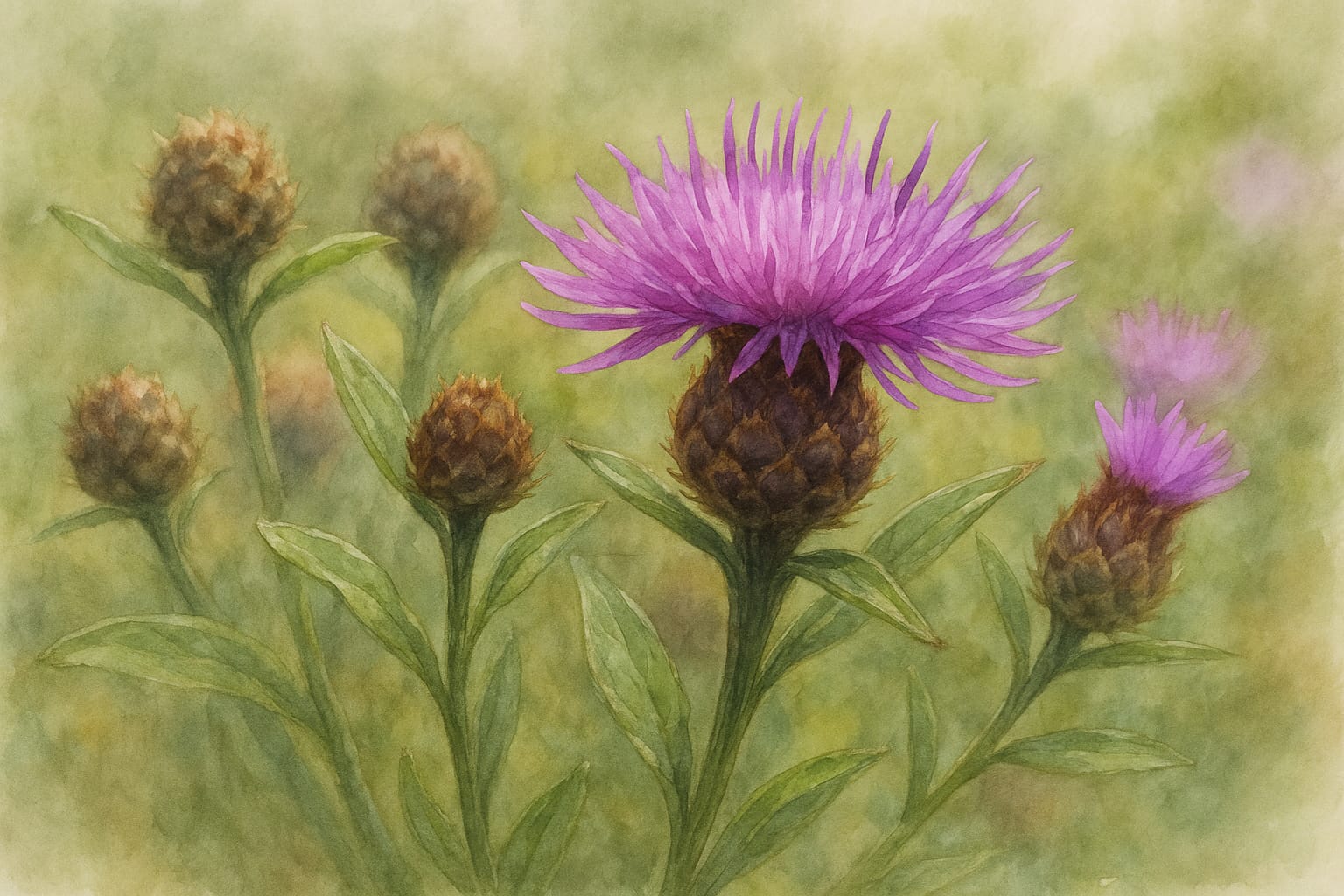
A Stalwart of Summer, Loved and Loathed in Equal Measure
There are wildflowers that demand attention with flamboyance—and others that simply arrive, hold their place, and quietly become essential. Common knapweed (Centaurea nigra) belongs to the latter. Its deep mauve buttons cluster like thistle-soft lanterns atop wiry stems, rising through Cornish meadows and verges with quiet authority. Seen en masse in high summer, it paints the landscape with a steady pulse of purple, rich with life. But beneath this generosity lies a complexity not immediately visible: one that challenges us to think deeply about biodiversity, balance, and the long view of soil.
The Buzz of High Summer
Walk a sunlit field in August and knapweed is rarely alone. Its flowers are landing stages for a cast of insect visitors: bumblebees, soldier beetles, skippers, hoverflies, honeybees, burnet moths. With a long flowering window from June into early autumn, it provides nectar when other native blooms have faded—offering a vital late-season lifeline.
It’s not just pollinators that benefit. Once the petals fall, knapweed becomes a granary for birds. Goldfinches and linnets cluster on its seed heads, plucking sustenance from the dry remains. Through this dual role—feeder of wings and builder of webs—knapweed secures its place as a keystone of Cornish wildflower meadows.
Garden-Friendly, Yet Wild at Heart
Knapweed thrives where many plants hesitate. Poor, stony soil? It will take root. Wind-scoured hillside? It holds fast. Once established, it needs no pampering. Drought does not dissuade it. Pests mostly pass it by. It grows straight and proud, self-seeds modestly, and rarely requires more than an end-of-season cut.
In the garden, it suits:
Its upright habit makes it a beautiful contrast against lower-growing companions like vetch or wild marjoram, while its nectar profile means it supports biodiversity in all seasons.
Below the Surface: A Complicated Guest
But Centaurea nigra is not simply benign. Underground, it speaks a different language—one of allelopathy and chemical rivalry.
Through its roots and decomposing leaves, knapweed releases compounds that can suppress the germination and growth of neighbouring species. These chemicals can also alter the composition of soil fungi and bacteria, particularly the arbuscular mycorrhizal fungi many plants rely on for accessing water and nutrients.
In short: knapweed subtly changes the neighbourhood. It may tip the microbial balance in its own favour, making the soil less friendly to other wildflowers. Even after removal, this shift can linger—an invisible legacy that alters future plant communities.
Between Native and Nuisance
Though native to Britain, common knapweed can behave like an opportunist invader in overgrazed pastures, disturbed verges, or abandoned fields. In these situations, it spreads aggressively, forming dense monocultures that crowd out more delicate species and reduce floral diversity.
This loss is more than aesthetic. With fewer flower shapes and bloom times, pollinator choice diminishes. Structural variation decreases, affecting insects that nest, feed, or shelter among different plants. Even soil chemistry can shift, affecting the health of wider ecosystems.
Knapweed’s strength becomes its threat when left unmanaged.
Balance Through Design
The answer is not to vilify, but to curate. In carefully managed gardens and meadows, knapweed thrives without dominance. It becomes a strong stem among many, part of a symphony rather than a solo.
To encourage this balance:
In this way, it can serve as anchor rather than conqueror—holding soil, feeding bees, and contributing to a mixed, resilient tapestry.
A Flower for Changing Landscapes
In a time of shifting climates and fragmented habitats, the tough, nectar-rich, drought-tolerant knapweed has much to offer. But its presence must come with a gardener’s eye and a naturalist’s ear. It is a plant that rewards attention, not neglect.
In Cornwall, where gardens flirt with wilderness and meadows meet the sea, Centaurea nigra fits easily into the landscape. It reminds us that resilience and richness are not opposites—but partners. And that even the most unassuming wildflower can carry both risk and promise beneath its bloom.
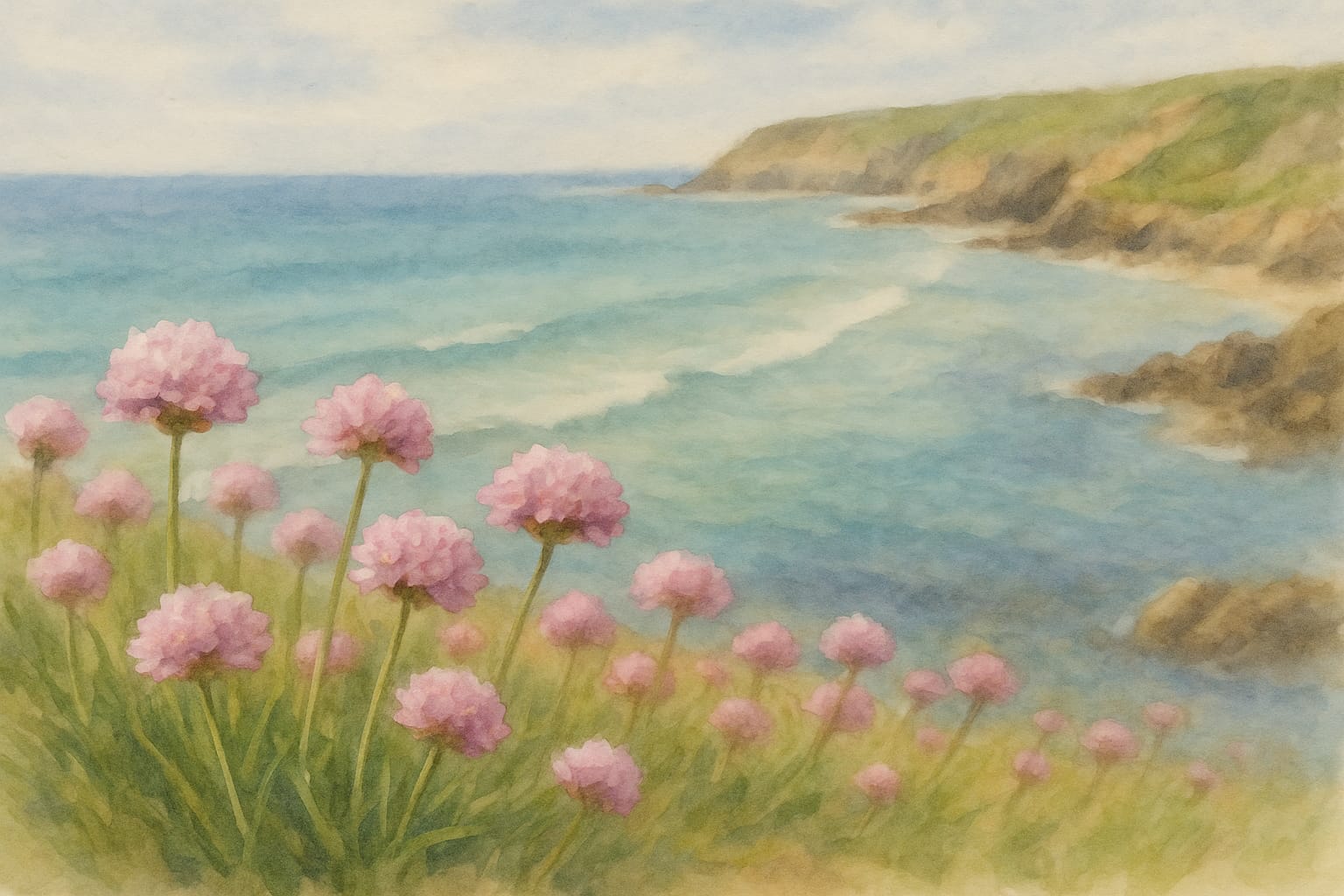
Thrift: A Coastal Spirit of Endurance and Quiet Bloom
Along Cornwall’s jagged cliff paths and salt-washed slopes, a pink softness appears each spring, defying the wind. Armeria maritima, known more affectionately as Thrift or Sea Pink, dots the coastline with its round, papery blooms, each one a small defiance of the sea’s blunt force. Hardy, modest, and deeply tied to place, it’s a flower that wears resilience as gracefully as colour.
A Coin-Sized Symbol of Strength
Not many wildflowers have carried national meaning in quite the same way. Between 1937 and 1952, Thrift appeared on the British threepence coin—a stylised image of clustered blooms, chosen not for opulence, but for what the plant represented: care with resources, quiet strength, and tenacity. It was the ideal wartime emblem, reminding households that frugality had beauty and value.
In the Isles of Scilly, Thrift is more than symbolic. It carpets the coastal edges in such dense pink waves that the land seems to blush into spring. There, and on the Isle of Bute, it holds official recognition as a county flower—woven into cultural identity as much as ecological landscape.
Names, Poems, and Quiet Power
The Welsh call it clustog Fair (“Mary’s pillow”), a name that captures both softness and sanctity. Its gentle form has long found its way into local stories, healing practices, and even poetry. John Betjeman, charmed by its contrast to harsh headlands, referenced it as a softening presence in his poem A Bay in Anglesey. There’s something inherently comforting about Thrift—a kind of plant that brings the domestic into the wild.
From Cracks in the Rock to Containers in the Garden
Thrift’s natural habitat—salty, exposed, nutrient-poor—makes it an ideal candidate for low-maintenance gardens and rugged spaces. It needs very little, and gives generously.
Growing Profile
It excels in gravel beds, rockeries, dry borders, and even balcony pots, especially where lean soil and long sun hours are the rule.
Care Notes
Its compact habit also makes it useful for edging paths or softening the base of taller coastal plants like sea holly or eryngium.
A Wildflower of Practicality and Presence
In the Cornish landscape, Thrift is more than decorative. It plays an ecological role stabilising soil, reducing erosion, and supporting pollinators with its nectar. Its tolerance for salt, wind, and drought makes it increasingly relevant as a climate-resilient species, perfect for modern gardens shaped by extremes.
Even in a small space—a single planter by a front door—it brings something timeless. A reminder that beauty doesn’t always shout. Sometimes it sits quietly in pink, clinging to a rock, and simply endures.
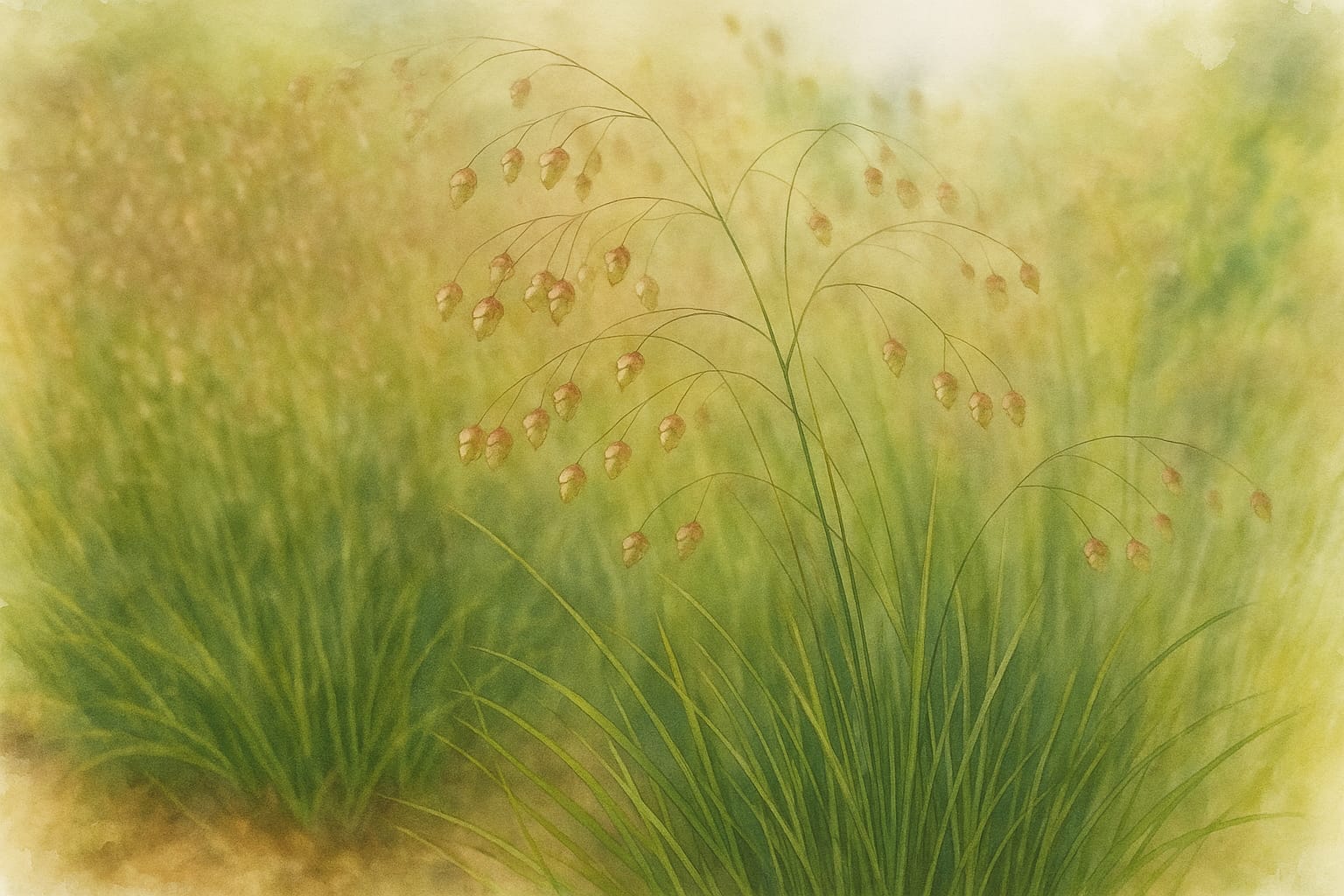
The Meadow's Murmur: A Grass That Speaks of Time, Texture, and Balance
In a world of bold flowers and assertive foliage, Briza media asks for almost nothing. It arrives softly, trembling in the light. A grass whose movement is its message, it lives not in flash but in feeling—its heart-shaped seed heads swaying on fine stems like bells in a wind only it can hear. This is the grass of still places, old fields, and memory.
In Cornwall, it is a quiet signature of landscapes once common and now rare. To encounter quaking grass in the wild is to stumble upon continuity: an echo of traditional land use, an unbroken line of biodiversity, a whisper from the days when hay was cut with scythes and meadows were mosaics of life.
Old Meadows and Rare Soils
Briza media does not seek attention. It simply stays where conditions suit it—and in doing so, marks the presence of something precious. It favours species-rich grasslands that have escaped agricultural intensification, areas where the soil remains light and undisturbed. In Cornwall, its strongholds lie mainly along calcareous coastal slopes, the serpentine landscapes of the Lizard, and inland meadows with neutral or lime-influenced soils.
These are places where yellow rattle softens the sward, where orchids and thyme bloom beneath the hover of bees, and where the rhythm of grazing still follows ancient patterns. Where Briza media grows, it grows with others. It never dominates, never crowds. It simply sways, content to coexist.
And yet, it is scarce. In Cornwall, quaking grass is classed as locally rare, lost from many of the landscapes it once adorned. Its absence often tells us as much as its presence—speaking to the erosion of ecological time and the drift toward uniformity.
A Living Ornament, A Working Plant
To gardeners and naturalists alike, Briza media holds dual appeal. Its ornamental qualities are undeniable: the pendulous, nodding seed heads catch the sun, casting flickers of light and shadow. In naturalistic designs, they bring movement where colour fades, subtlety where structure stiffens.
In dried form, the grass holds its charm through winter. As a living presence, it carries out quiet work—binding soil, hosting insects, supporting birds. Its roots contribute to stable soil profiles in sloped or coastal gardens. Its seeds feed finches and sparrows. Its very form shelters beetles, moth larvae, and spiders, tucking microhabitats into every quiver.
There is elegance in its modesty. Briza media does not need fertiliser, elaborate pruning, or rich compost. It thrives in adversity—on lean soils, with little water, under sun and salt and wind. And in a warming world, that resilience is more than decorative. It’s strategic.
The Grass That Trembles and Tells
Folklore has always paid attention to movement. The trembling of Briza media gave rise to old beliefs: that the plant was attuned to spirits, that it could soothe nervousness, or that it held properties aligned with the body's hidden rhythms. Herbalists once used it sparingly to calm digestion or relieve tremors, reading clues in its soft gestures.
Such associations have faded, but the symbolism remains. This is a plant that appears when balance is present—and vanishes when it is not. It tells gardeners and ecologists what the land can support, what has been lost, and what might return.
Growing Briza media in the Cornish Garden
To welcome Briza media is to commit to restraint. Rich soils, frequent feeding, and dense competition will stifle it. But in the right space—sun-drenched, well-drained, minimally disturbed—it will reward with beauty and biodiversity alike.
Ideal Conditions:
It pairs beautifully with other low-nutrient lovers: Achillea millefolium, Scabiosa columbaria, Anthyllis vulneraria, and native sedges. It also makes a textural foil to showier native wildflowers, especially in soft palette schemes that reflect Cornwall’s natural coastlines and dunes.
Holding the Edges Together
As our gardens become more than visual pleasures—transforming into sanctuaries, carbon stores, and stepping stones for wildlife—plants like Briza media become indispensable. They ask for little. They offer much. And they fit the new brief: adaptability, ecological function, aesthetic grace.
More importantly, they restore a thread between land and legacy. Quaking grass brings the sound of old fields back into the present. Its movement reanimates the quiet choreography of insects, birds, and wind that once defined the high summer meadow.
To plant it is to plant a memory—not one of nostalgia, but of possible continuity.
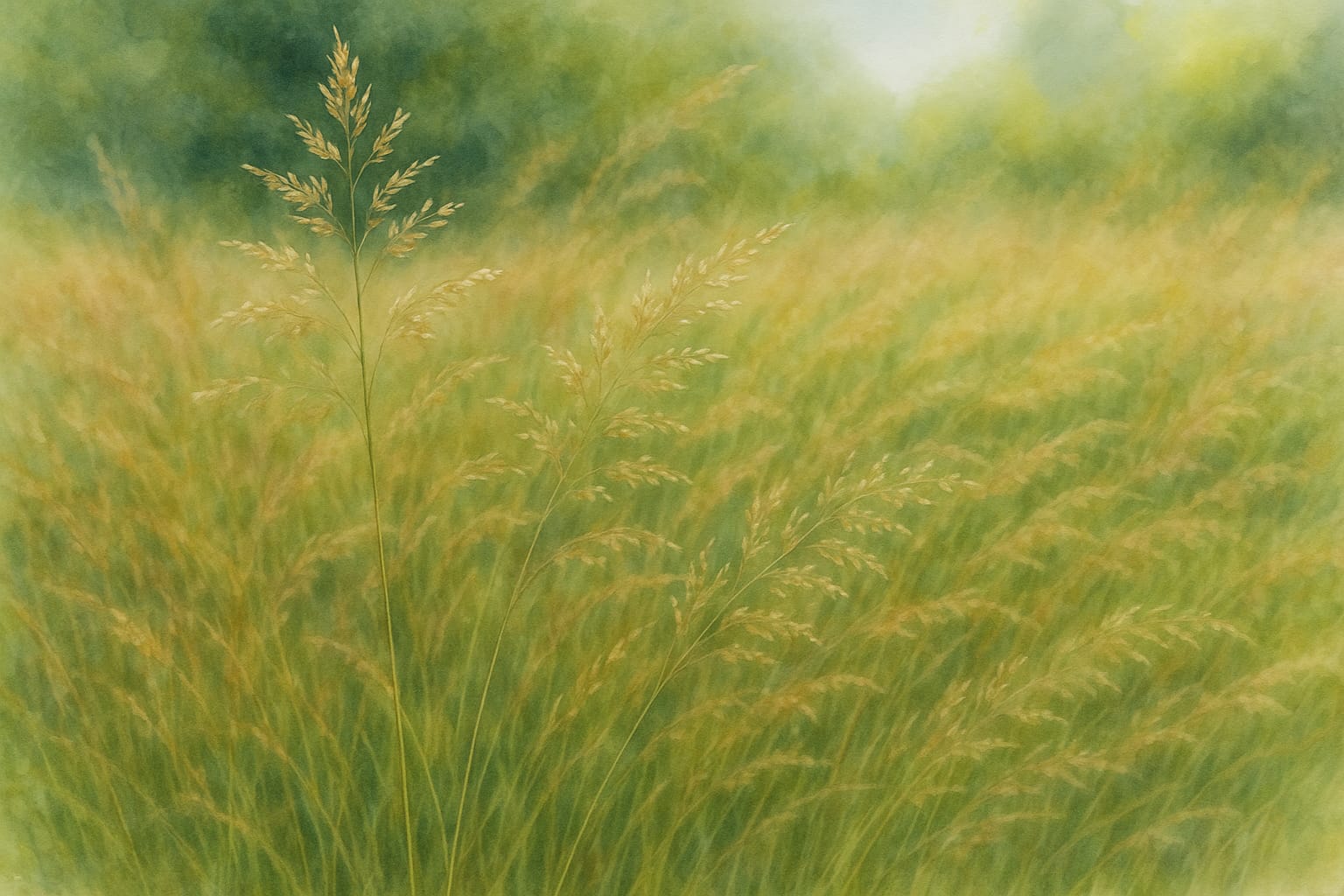
Beneath the Breeze: The Quiet Architecture of Agrostis in the Cornish Garden
Fine-leaved and resilient, bentgrasses (Agrostis spp.) shape some of Cornwall’s most quietly beautiful landscapes. From acid moor to garden lawn, this feature traces their ecological role, botanical identity, and enduring importance in biodiversity-rich design.
Where the Light Touches the Land
In Cornwall’s open places—where mist drifts low over heath, where fields breathe beneath the wind, and where the bones of old farms still shape the land—there is a grass that often goes unnamed. It does not dazzle, nor demand. Yet it holds the soil, frames the view, and lets the wildflowers breathe.
These are the bentgrasses, or Agrostis spp.—a family of fine-textured grasses with global roots and local poetry. In Cornwall, they thread through upland and lowland, through rush pasture and sandy verge, offering a kind of vegetal stitching between habitats. Their work is quiet, but essential.
A Grass with Many Names, One Character
The genus Agrostis appears across continents, but its Cornish manifestations are especially expressive. In the subtle distinctions between species lie clues to soil, water, light, and legacy.
Field identification is not always easy—ligule shape, panicle openness, stolon presence, and awn details are needed to separate species. But a sense of place will often give them away. Each species tells a story about where it grows.
A Tapestry Across the County
In Cornwall, bentgrasses are not confined to a niche. They stretch wide and deep across ecosystems:
The Soil They Love—and the Soil They Heal
Bentgrasses thrive where many other grasses do not. Acid soils, sandy loams, and post-industrial spoil—all may host Agrostis species. In fact, excessive fertility can push them aside. Where soil is low in nutrients but rich in subtle minerals (as with Cornwall’s serpentine geology), bents flourish.
Their roots are fine, but plentiful. They stabilise, aerate, and host an invisible community of fungi, microbes, and soil invertebrates. In doing so, they support the nutrient cycling and carbon storage that help keep ecosystems in balance.
Some species, such as Redtop (A. gigantea), are known to survive in soils with a pH as low as 4.5. This makes them valuable for ecological restoration, especially in areas degraded by past mining or farming.
Life Among the Blades
Bentgrass-dominated swards are often where the most complex, life-filled communities take shape. Their open structure permits an array of herbaceous plants to flourish—each of which, in turn, supports insects, birds, and small mammals.
Hoverflies, moths, solitary bees, and spiders use these grasses as home and hunting ground. Skylarks and meadow pipits nest among them. Voles and shrews forage at their base. This biodiversity is not accidental—it is made possible by the fine, shared space bents allow.
In some Cornish meadows and heaths, over 25 plant species may co-occur within a four-metre square patch of bentgrass sward. That is not just diversity—it is coexistence.
For the Garden and the Future
Bentgrasses will not suit every border, nor will they appeal to those seeking visual drama. But for those drawn to the spirit of Cornwall’s meadows and moors, they offer authenticity. A wild lawn seeded with A. capillaris will move like a hillside in the wind. A rain garden bound with A. stolonifera will stay soft, spongy, and green long after others fade.
As gardeners, land stewards, and designers begin to think more about biodiversity and soil health, bents are re-emerging—not as utility turf, but as functional beauty. They are not a trend. They are a return.
In the story of Cornwall’s landscapes, Agrostis species are not the main characters. They are the stage, the scaffold, the texture beneath the bloom. They have endured centuries of weather, grazing, cultivation, and change. And still, they move beneath the breeze—quietly upholding the gardens of soil, story, and place.